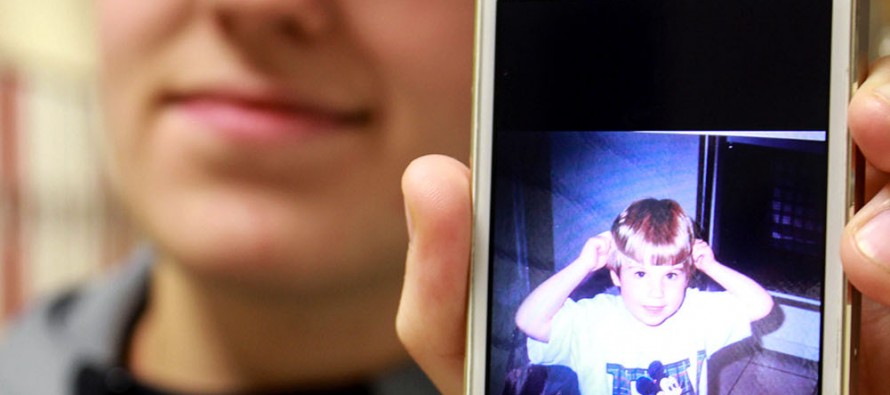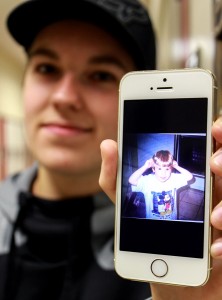Stuck in the middle


WINDSOR, Ont. (12/03/15) Brock Mulligan, 20, holds up his iPhone showing a photo of when he was younger inside the MediaPlex on Tuesday, Dec. 2, 2015. The photo depicts Mulligan when he was younger and when he identified himself as a female. Mulligan is in the middle of transitioning from female to male. PHOTO BY/ Millar Hill
By Millar Hill
Each morning 20-year-old Brock Mulligan follows the same routine. After he fights a short but strenuous battle with the snooze button on his alarm clock, he gets dressed in clothes that hide the body he was born in. For some, a pair of jeans, a tee shirt and a baseball cap are just clothes. But for Brock, these clothes distract him from the real issue.
Trying to decide what to study in school or finding work may be a big priority for some young adults, but for Mulligan, his priority is taking the necessary steps needed to finally feel comfortable in his body. He is one of many transgender people in Ontario on the long wait list to see and be examined by a physician at CAMH, the Centre for Addiction and Mental Health in Toronto.
CAMH is the only clinic in Ontario where a transgender person can get referred for hormonal medications and sexual reassignment surgery. The wait times are anywhere from two months to a few years.
Born a female
On Jan. 28, 1995, a baby girl was born, Brooke Idamay Mulligan, the youngest of her siblings, Taylor, Ashley and stepbrother Ashton. As she grew older, she did not feel nor want to be a girl. Her interests were dirt bikes and four-wheelers. Instead of stealing her older sister’s dresses and make-up, she would steal her stepbrother’s clothes. At age seven Brooke started to become confused with herself and felt uncomfortable in the body she was born with.
“When I was younger, I had no idea what was happening or know how to explain my feelings,” Mulligan said.
As a girl, Brooke was the tomboy type. She had dirty blonde mid-length hair and always wore boy clothes, including dirt bike shirts. Now, Brock is your average guy. He has a slim, muscular build. The sides of his head are shaved with longer blonde hair on top. He wears shirts are one size too big to hide his female features.
As a young girl Mulligan said she would make subtle hints to her parents to see their reaction to her wanting to be their son. One year for Mother’s Day, he wrote, “love your son/daughter” on the card.
Mulligan recalls asking his parents if he could be called their son.
“When we would go shopping, I would go right to the boy section,” he said. My mom would be like ‘well what about girl clothes?’ and I would say no, I’m not comfortable wearing those.”
Mulligan’s parents always complied with young Brooke’s wishes. He says his parents never stopped him from expressing himself. They may have been confused but they supported him.
Mulligan’s father Bernie passed away from cancer in 2012. Mulligan struggled with his father’s death. He never told his father that he was transgender but always had a hunch he knew.
Mulligan says his father’s death gave him strength to begin his transition.
Starting to identify
Dr. Wally Coates, a physician at the Windsor Family Health Team, says transgender youth start to realize they do not identify with the gender they were born into as early as the age of five. He says it is common for youth to start adapting to certain qualities as the gender they identify themselves with.
“Usually the youth will often start to identify with the one gender and often dress that way and prefer their hair cut short if they’re trans male or grow their hair long if they identify as female,” said Coates.
Coates says once a transgender person has identified with a specific gender and chooses to transition, they have to find a medical practitioner who is comfortable with this field of work. As far as Coates knows, the Windsor Family Health Team is the only local doctors office that has made a point of being LGBT-friendly.
“A lot of them have been denied access to treatment and to hormones mainly because not many doctors are trained,” said Coates, who has counseled 10 transgender patients through their transition.
According to Coates, while a person is transitioning and progressing through the process, they may face risks to mental health issues.
“The major risk is psychological,” said Coates. “So depression and anxiety is usually due to the gender dysphoria but perhaps due to social factors – rejection by family members or friends who don’t understand.”
Mulligan said he started dealing with depression in Grade 10. There were days where he would think about the body he was born with so much, he did nothing but sit in his room alone.
“The labels of being a lesbian or people wanting you to be someone you’re not,” said Mulligan. “Being so young, it was so hard. At times I felt like I didn’t know what to do.”
Mulligan has been on the waiting list for a year to be approved for hormone medication.
Transgender individuals are at a high risk of committing suicide while waiting, according to David Jensen, the spokesperson for the Ministry of Health and Long-Term Care.
Dr. Coates was shocked when he came across the statistics of suicide attempts amongst transgender people.
“Prior to transitioning, 27 per cent attempt suicide and 50 per cent think of suicide,” said Coates. “After starting therapy, this decreases to 10 per cent attempting suicide. By the end of transitioning, only one per cent attempt suicide.”
Mulligan has never thought of suicide but says it is very difficult being in the middle of transitioning. He is living in a body he is not comfortable in and feels like he is just dragging along.
Jensen says the government is working to fill in the gaps of services to improve the health status of trans people living in Ontario by providing patients with faster access to specialists. Other qualified professionals will soon be able to make recommendations for surgery in 2016.
Mulligan plans to go all the way with his gender transition by having surgery, but for now he eagerly waits to start taking his testosterone.
“I want to get my pills and surgery,” said Mulligan. “I just want to get it going.”


